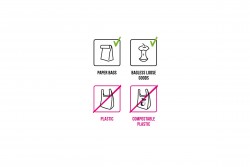Facts or Myth “Biodegradability”
All bio-based plastics are biodegradable – It’s a myth. Bio-based plastics can be either biodegradable or non-biodegradable (durable). Bio-PET, also known as bio-sourced PET, is a non-biodegradable bio-based plastic that has been around for some years. Bio-PET can replace fossil-based PET in a range of applications. An example is the “Plant Bottle”, a fully recyclable plastic bottle that is made partially from plants. Some bio-based materials, including Bio-PET, are chemically identical to fossil-based ones, so they carry the same properties. They are also called drop-in solutions. PLA, short for poly lactic acid, is a biodegradable bio-based plastic. It is used for a range of applications, including mulch films, tea bags, drinking cups, and in 3D printing. PLA is transparent and approved for food contact applications and therefore very suitable for food packaging. PHA, short for poly hydroxyl alkanoates, are polyesters, a kind of polymer, produced in nature by numerous microorganisms, including through bacterial fermentation of sugar or lipids. They are also biodegradable and offer the potential to create bio-based plastics with novel properties. If a product is biodegradable, I can throw it into the environment and it will disappear – It’s a myth. Even though a product might be claimed as biodegradable or compostable doesn’t mean you can just throw it into the environment. The right treatment of a product at its end of life is very important. Biodegradability does not automatically mean that a product will degrade in any environment. In most cases industrial composting with specific conditions is needed to ensure biodegradation within a reasonable period. European standards require that in industrial composting facilities materials need to biodegrade within six months, but in open environments, it will take much longer. And if you wait for hundreds of years, even “durable” goods will start to degrade. Besides, biodegradable plastics are no solution to littering, and can be a sore to the eye. Apply reusable products and materials whenever possible. If a product is biodegradable, I can easily compost it at home – It’s a myth. Compostable means that material is certified according to the European standards EN 13432 (packaging) and EN 14995 (products) and is composted in industrial plants. In most cases biodegradable plastics will only degrade in industrial composting plants under specific conditions, because compostability or biodegradability does not automatically mean that a product will degrade in any environment. Degradation is dependent on factors such as temperature, time, humidity, and the presence of bacteria and fungi in the specific environment. These factors can be controlled only in industrial composting plants. Nevertheless some products might be suitable for home composting. Even though a European standard for home composting does not yet exist, there are a few standards on national level already in place. Two examples for home composting labels are: Composting of bio-based plastics only makes sense for specific applications where recycling is too difficult, for instance, because the packaging is highly contaminated with organic residues. An example where composting makes sense is the use of tea bags. To seal tea bags, most tea bags consist of 20-30% of the fossil plastic PP (polypropylene). These tea bags often end up in the composting bin, although they are not compostable. By replacing the PP with PLA the tea bag becomes fully industrially compostable. Read more: http://www.allthings.bio/fact-or-myth/facts-or-myth-biodegradability/(opens in new window)
Keywords
Countries
Germany



